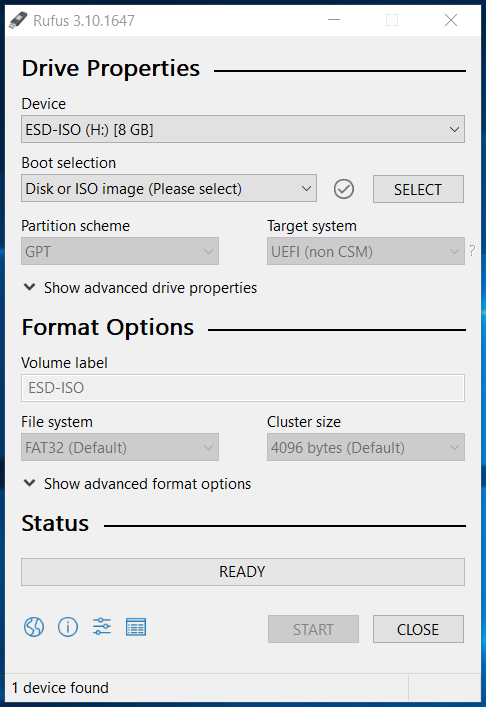

- CREATE WINDOWS 10 BOOTABLE USB FROM ISO RUFUS 64 BIT
- CREATE WINDOWS 10 BOOTABLE USB FROM ISO RUFUS DRIVER
- CREATE WINDOWS 10 BOOTABLE USB FROM ISO RUFUS 32 BIT
- CREATE WINDOWS 10 BOOTABLE USB FROM ISO RUFUS UPGRADE
The only potential issue has to do with Secure Boot (a.k.a. Unless a manufacturer's UEFI firmware is broken, an USB drive created with Rufus will seamlessly boot from NTFS, and the vast majority of people won't even realize that they aren't booting from FAT32 (because, as I pointed out, it really doesn't make a difference as far as UEFI is concerned). The thing is, there's nothing to clarify. I'm afraid that the only thing I see is to try to contact HP and see if they have a BIOS update. Unfortunately, it is not possible to move the UEFI:NTFS partition at the beginning of the USB drive, as, due to Windows limitations, this would make the rest of the USB content inaccessible for people using USB flash drives with the removable flag set (at least 95% of all flash drives out there).
CREATE WINDOWS 10 BOOTABLE USB FROM ISO RUFUS DRIVER
Either that or it has an issue reading FAT16 content, but that would be very surprising as the FAT16/FAT32 UEFI driver is fairly standard and is pretty much the same for every firmware out there as it is provided by the UEFI developers in the base firmware. If it isn't listed even when Secure Boot disabled, it looks like a clear indication to me that the HP "BIOS" isn't looking at all the UEFI bootable partitions as it should. While there's always a possibility that there might be a problem in the bootloader itself, at the very least, if your system conforms to the UEFI specs, it should detect the bootloader and allow you to boot from the USB, and you should see some output from that bootloader. Rufus does follow the UEFI specs with regards to how it creates an UEFI bootable drive for UEFI:NTFS. Yes, at this stage I don't know what I could do in Rufus or UEFI:NTFS to help you out. On many UEFI firmwares, you will have to select Other OS somewhere under Boot settings in the Secure Boot category. Most likely you need to locate the Secure Boot option, and disable it. Question: Could it be that my HP Laptop BIOS needs a USB 2.0 Stick to boot UEFI:NTFS? Otherwise, the other possibility I see is that your UEFI firmware is not following the UEFI specifications and expects the EFI partition to be the first one, whereas the specs indicate that it can be anywhere, and Rufus has to place it at the end so that the content of the drive remains accessible from Windows. So you have to temporarily disable Secure Boot to use UEFI:NTFS (but you can re-enable it once Windows is installed). If you just copy the files onto a FAT32 partition as per the guide you pointed out, this will be the case, but it will not be the case when using UEFI:NTFS from Rufus. Rufus' UEFI:NTFS will only work if you have Secure Boot disabled, because the UEFI:NTFS bootloader is not signed by Microsoft, and your symptoms could easily be explained with the HP "BIOS" having Secure Boot enabled, and only allowing boot from USB if the UEFI boot loader it sees is signed. Yes, I tried booting the USB created with Rufus 2.3Īre you sure you have Secure Boot disabled then?
CREATE WINDOWS 10 BOOTABLE USB FROM ISO RUFUS 32 BIT
Unlike I don't believe you have a 32 bit UEFI firmware.

Yes, that's why I said issue was not the same.
CREATE WINDOWS 10 BOOTABLE USB FROM ISO RUFUS 64 BIT
My Laptop runs Windows 10 Home 64 bit perfectly!
CREATE WINDOWS 10 BOOTABLE USB FROM ISO RUFUS UPGRADE
I have no way to upgrade this machine to a 64 bit OS or reformat it. I'll try to buy some time to continue working with it. This wouldn't be that serious of an issue except I can't get it to boot properly and my customer expects me to fix it ASAP. I can't run the windows installer directly because the exe is 64 bit and the laptop has 8.1 32 bit installed even though it is 64 bit capable. (Not that I though it really would).Īnd also UEFI MBR NTFS which has the same result as UEFI GPT NTFS. This created a second identical bootable device which also didn't work. So I took 'bootia32.efi' from the FAT partition named UEFI_NTFS and put it with 'boot圆4.efi'. I figured maybe it was my ISO and sure enough 'bootia32.efi' was not in 'efi\boot\bootia32.efi', only 'boot圆4.efi' was. Launching NTFS EFI loader 'efi\boot\bootia32.efi'.

Loading the first NTFS partition on this device.


 0 kommentar(er)
0 kommentar(er)
